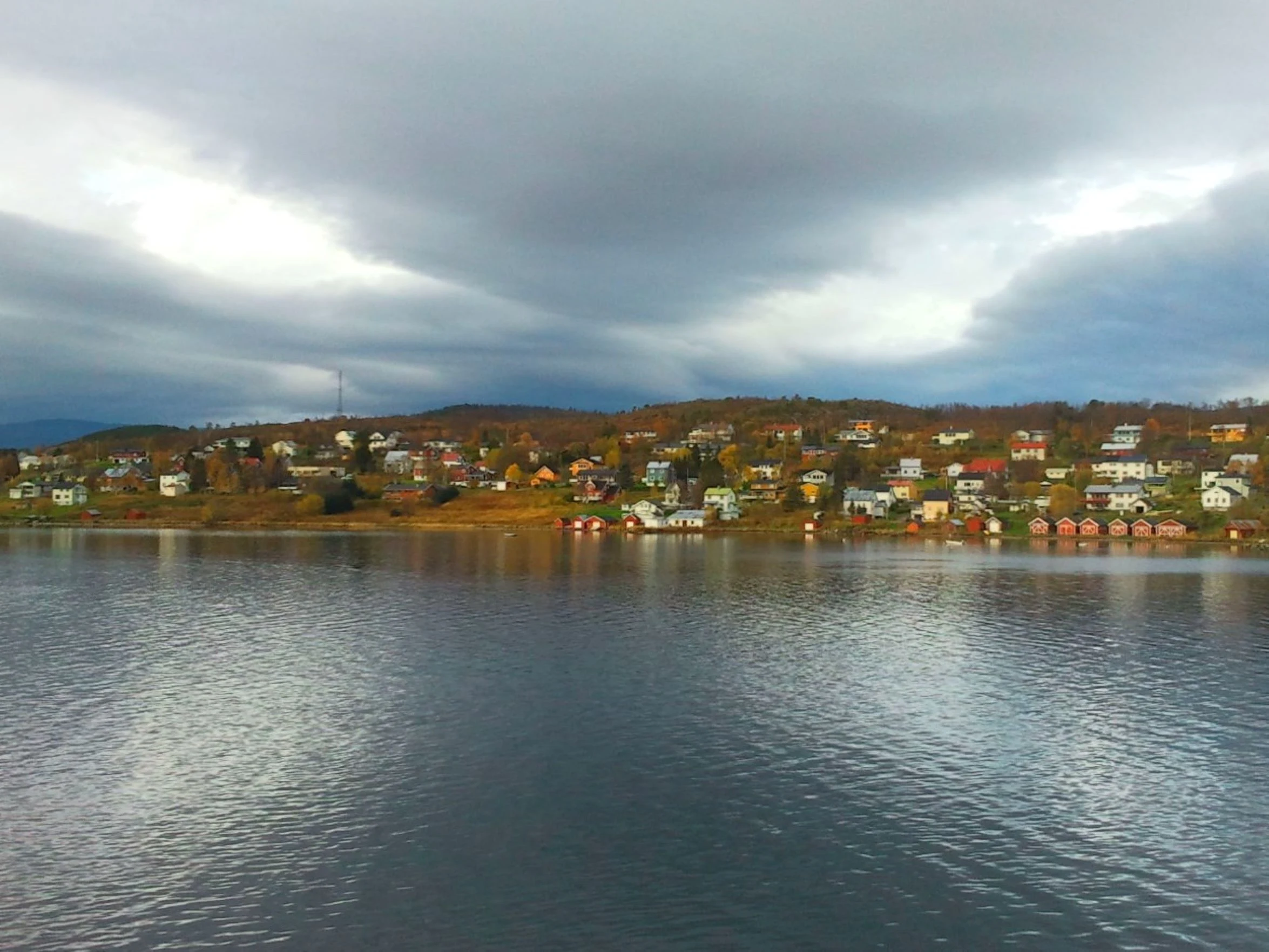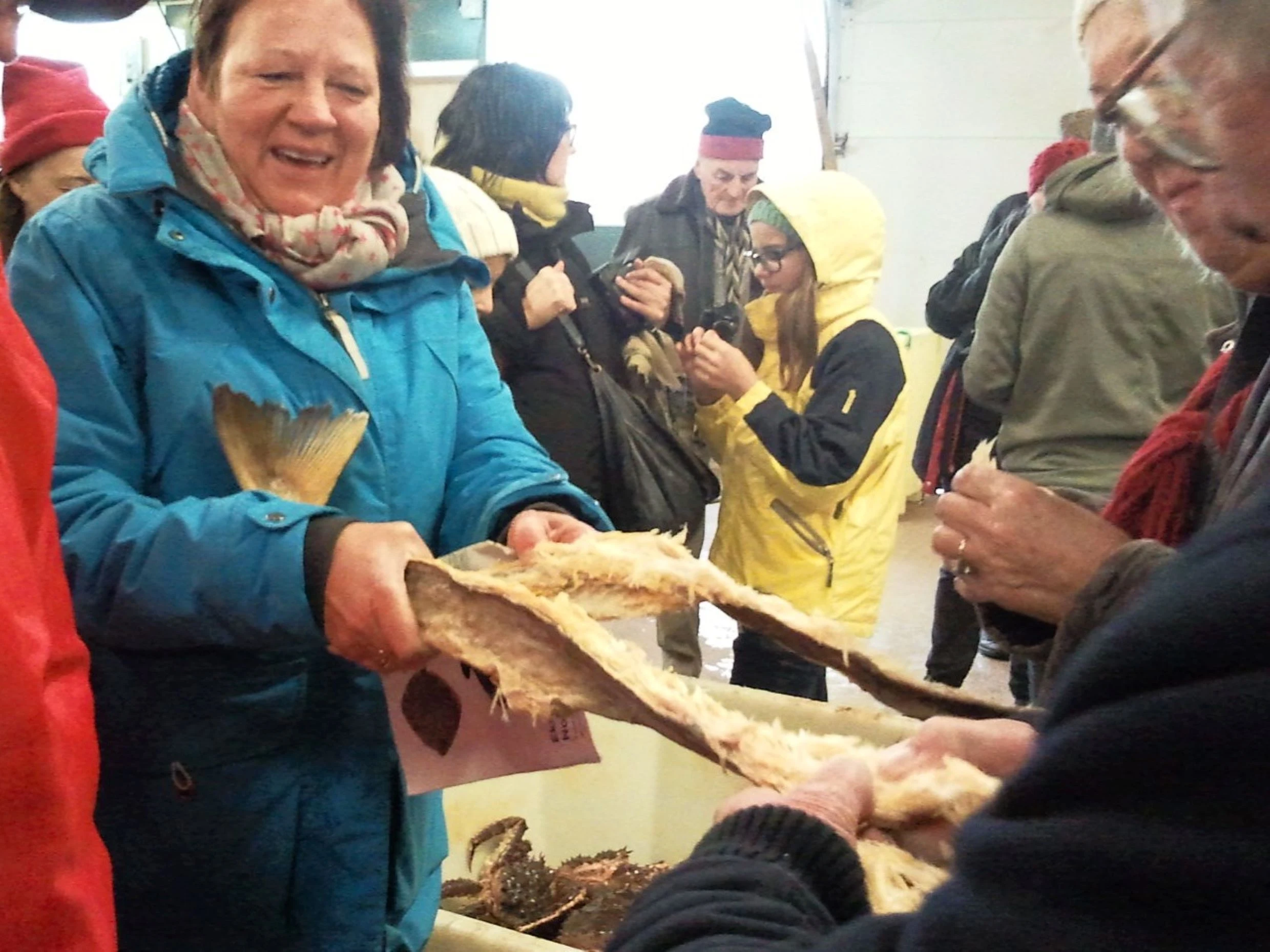We’d been in our motorhome touring northern Europe, but left it in Oslo to catch a train to Bergen, where we picked up a cruise to see Norway’s famous fjords. We thought we’d seen the best of the scenery in the fjords, but then the ship arrived at 66ᵒ 33” north to cross into the Arctic Circle.
 |
| Approaching 66ᵒ 33” north to cross into the Arctic Circle |
The scenery there was hauntingly beautiful in the morning mist. The Artic Circle, aka the North Pole, is the northernmost region of earth and one of the coldest in winter, which is when we were there.
As the ship approached the Circle, the captain announced a special ceremony to mark the crossing. So everyone rugged up and went out on deck. There we saw King Neptune!
The ceremony involved King Neptune (or the captain) putting ice cubes and water down your back before you received a shot of alcohol to warm you up. Leigh chose King Neptune to receive her dipping, and got heaps of water and ice down her back and ended up rather wet.
Marg cleverly chose the captain and only got a little water down her back as he was much kinder. All good fun and most people joined in. We got a certificate to say we have crossed the Arctic Circle.
Sailing on, we reached the northern village of Ørnes which dates back to 1794. Ørnes is one of the largest settlements in the area with a population of around 1,700. It looked very quaint, nestled between the base of the mountain and the ocean. Ørnes is known for the second largest glacier in Norway, the Svartisen, which we caught a glimpse of from the ship.
 |
| Houses with Bremnes Fortress above, Bodø, Norway |
A little later we arrived in Bodø where we took a walk into the village to stretch our legs. Bodø township dates back to 1816, but the area dates back almost 10,000 years. It is a quirky town with interesting shops and cafes, and we enjoyed our time there. Near the shoreline, we could see the Bremnes Fortress, a German fort built by prisoners of war in 1940.
Next, we reached the Lofoten Islands, and stopped in the main town called Svolvær. After walking around town, we found the ‘Magic Ice Gallery’, the first and only permanent ice gallery in the world. It is a bar where temperatures are kept below zero, and ice sculptures are on permanent display. Even our drink glasses were made of ice.
Although we were dressed in very warm clothes, they provided us with additional fur-lined capes. We needed them too, as it was absolutely freezing inside. It was hard to take photos because your hands froze being out of your gloves for only a few seconds - but the ice sculptures were amazing.
Later that night the ship made a detour to the beautiful Trollfjord. What an amazing experience as the fjord was incredibly narrow and it was dark. We crept along nearly touching the huge walls of rock, and with searchlights picking out waterfalls and autumn colours in an eerie, magical sort of way.
It was a wonderful experience, and we even had a special Trollfjorfknert, a “magic” drink to mark the moment, and were able to keep the Trollfjord cup as a souvenir
 |
| Finnsnes area settlement, Norway |
The next day we stopped at small places like Harstad and Finnsnes for thirty minutes to deliver and pick up mail and goods before moving on. The landscape was becoming even more rocky, isolated and desolate. The autumn colours and red houses give it a lift but it must be a hard place to live in. Fishing is the main occupation in Finnsnes, and we have passed many salmon farms on the way.
 |
| Leigh in Tromsø, Norway |
Next, we docked in Tromsø, the capital of the Arctic and famous as a great place to see the Aurora Borealis (Northern Lights). In fact, we had planned to stay in Tromsø for a few days for that reason.
However, we’d seen the Aurora from the ship twice while visiting the fjords, so changed our plans to stay with the ship as it sailed further north. We thought that would increase our chances of seeing the Aurora again, while also seeing more of northern Norway. The ship crew were very accommodating, and we were even able to keep the same cabin.
That night, we crossed the open stretch of sea across the top of Norway. There was a lot of rocking and rolling but we have now become quite seasoned to it, and enjoyed watching and listening to Norwegian folk music and dance in the ship’s lounge.
The next morning, after short overnight stops at various villages, we docked at Honningsvåg, a quaint but isolated fishing village.
 |
| Us at North Cape, Norway |
In Honningsvåg, we hopped onto a mini-van to cross the 71st parallel to the sub-Arctic landscape of the North Cape. It is the northernmost point on mainland Europe, and populated by the Sámi people who are indigenous to this part of the world.
The Cape plateau rises 307 metres almost vertically from the Arctic Ocean, and it was windy and terribly, terribly, cold, notwithstanding our numerous layers of clothing. However, it was also spectacular.
 |
| Leigh with fishing boats in Skarsvåg, Norway |
From North Cape, the bus drove along a twisting hilly road to the very small (population 45) and isolated fishing village of Skarsvåg. We met Heidi there, a local woman who had lived in the village all her life and has several small local enterprises.
She was passionate about her village despite the fact that the population was steadily decreasing. There is nothing to do there for 8 months of the year because of having no daylight, and being snowed under and/or being unemployed.
In Skarsvåg, they catch king crabs for the market, and cod (stockfish) for food. We saw cod drying on racks to prepare it for winter storage, and Heidi gave us some to eat. It was salty but tasty.
King crab is an introduced species that has thrived to pest level and damaged the natural eco-system. There are now so many that prices have dropped dramatically. The village is now in a financial crisis and there are fears for its ongoing existence.
A local fisherman bought out a crate of king crabs to show us and they were massive. At Heidi’s place later, she provided a tray of king crab legs, cooked and spilt open. You only eat the legs as the rest is shell and sinew. The meat was so juicy and sweet and we really enjoyed it.
 |
| Leigh outside the fort at Vardø, Norway |
Our next main stop was Vardø, the oldest town in northern Norway, and last town before the North Pole. It has a small fortress, last used in the 2nd world war to defend Norway. It is now home to the famous Enigma machine that decoded German messages and helped to end the war.
Later we docked briefly at the isolated town of Kirkenes, located right over the top of Norway in the extreme north-eastern part, near the Russian border. This is as far as this cruise goes, so the ship turned and reversed its route.
 |
| Sámi singer in the ship's lounge |
That night on board, we were entertained by a Sámi person singing traditional songs. The songs were interesting as they were about everyday life, such as catching a fish (or so he explained as it was all sung in Sámi language), but the melody was hard to listen to!
 |
| Aurora Borealis, Norway |
They lessened and we retired inside to defrost. A few hours later, we had another call, and the show was renewed. The lights were everywhere and we kept moving around the ship until they started to fade. We felt we had really seen some wonderful sights.
 |
| Leigh in Hammerfest, Norway |
Sailing south now, we arrived in Hammerfest, the polar bear capital. That afternoon, we were provided with a taste of the Arctic, being dried reindeer meat and cloudberries. The meat was delicious and the cloudberries were yellow berries that were slightly sour. They are a delicacy here and hard to come by so this was a special treat.
Still sailing south and after more short stops at small towns, we eventually arrived back in Tromsø and this is where we left the ship. It was at 11.45 pm so we taxied straight to a hotel, slept, and missed a distant Aurora Borealis showing! Aah well! We’d had two sightings through the fjords of Norway, and two sightings in the Artic Circle. We were certainly happy with that.
After a couple of days in Tromsø, we caught the local bus to the airport, and were farewelled with a spectacular rainbow over the city. We flew back to Oslo and were reunited with our motorhome Vanni, who was feeling a little chilly after being alone in a car park for 10 days. After we picked up Vanni, we drove south.
 |
| Fredrikstad old town, Norway |
Our next stop was the town of Fredrikstad which has an amazing fortified old town called Gamlebyen. It’s full of lovely old buildings and considered the best-preserved fortified town in the Nordic Region. We found the campground there, but it was closed. As it was getting late in the day, we found a car park by the edge of the Glomma Estuary and settled in for the night.
The next morning, we drove to Begby to see Bronze Age rock paintings made over 3000 years ago. The paintings illustrate the religion, culture and activities of people of the day. We had to negotiate very wet ground and slippery rocks to see them but were fascinated by them.
After leaving Begby, we headed south, out of Norway. What a fabulous experience we’d had in Norway. It is such a picturesque country. But it is getting very cold now so we crossed out of Norway and into Sweden again, but you can read about that in the next blog.
This blog describes part of our 6-month motorhome trip around north-eastern Europe, which began in Prague.










